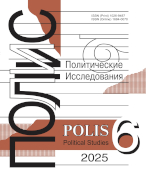Russia’s Post-Soviet Borderzone in Between East and West:
Looking West (Analysis of Political Discourse)
Kolosov V.A.,
Deputy Director, Head, Laboratory of Geopolitical Studies, Institute of Geography, Russian Academy of Sciences, vladimirkolossov@gmail.com
elibrary_id: 625820 |
Zotova M.V.,
Senior Research Fellow, Laboratory of Geopolitical Studies, Institute of Geography, Russian Academy of Sciences, zotovam@bk.ru
elibrary_id: 141138 |
Popov F.A.,
Research Fellow, Laboratory of Geopolitical Studies, Institute of Geography, Russian Academy of Sciences, fpopov15@gmail.com
elibrary_id: 623528 |
Gritsenko A.A.,
Research Fellow, Laboratory of Geopolitical Studies, Institute of Geography, Russian Academy of Sciences, ntohaha@yahoo.com
elibrary_id: 623821 |
Sebentzov A.B.,
Senior Research Fellow, Laboratory of Geopolitical Studies, Institute of Geography, Russian Academy of Sciences, asebentsov@gmail.com
elibrary_id: 618867 | ORCID: 0000-0001-9665-5666 | RESEARCHER_ID: AAG-6046-2021
DOI: 10.17976/jpps/2018.03.04
Kolosov V.A., Zotova M.V., Popov F.A., Gritsenko A.A., Sebentzov A.B. Russia’s Post-Soviet Borderzone in Between East and West: Looking West (Analysis of Political Discourse). – Polis. Political Studies. 2018. No. 3. https://doi.org/10.17976/jpps/2018.03.04
The article is devoted to the study of evolution of public perceptions of new Russia’s post- Soviet borderzone through the analysis of their representation in Russian press. “Nezavisimaya Gazeta” was chosen as a focus newspaper. The study is based on a database of publications collected through screening of this edition in four periods: 1994–1995, 2000–2003, 2008–2012 and 2013–2014. The newspapers titled “Sovetskaya Rossiya”, “Zavtra” and “Novaya Gazeta” were used as the sources of additional information. It has been found that modernized East-West dilemma serves as a framework of these representations. Russia faces a fundamental choice between two vectors. The Western (European) vector means the rapprochement with the members of the EU and NATO, adoption of their values and development models. The Eastern (Eurasian) one implies total or partial reintegration of post-Soviet space and creation of new autonomous center of power within upcoming multi-polar world. Debate about the future of newly formed borders and the whole post-Soviet space, about building relations with former union republics on the one hand and the EU and NATO on the other, about aims and composition of regional integration projects etc. has invariably focused on the analysis of this dilemma. From the 1990th there were changes not only with the balance between two vectors within the media political discourse (non-contradicted in early 1990th they turned in the middle of 2010th into opposite sides of a dichotomy while the eastern vector appeared to be a dominant one) but also with their proper understanding. This article concerns with the Western part of two-faced discourse that reflects the transformation of collective West from focus of consolidation, source of economic and political modernization and a role model to key geopolitical rival which de facto plays a role of the Evil on the world political map.
References
Berg E. Deconstructing Border Practices in the Estonian‐Russian Borderland. – Geopolitics. 2000. Vol. 5. No. 3. P. 78-98. https://doi.org/10.1080/14650040008407692
Foucault M. L’Archéologie du savoir. (Russ. ed.: Foucault M. Arheologija znanija. St. Petersburg: Gumanitarnaja Akademija. 2004. 418 p.)
Kolosov V.A. Critical Geopolitics: Basis of the Concept and an Experience of its Application in Russia. – Polis. Political Studies. 2011. No. 4. P. 31-52. (In Russ.)
Krasteva A. Spaces, Lines, Borders: Imagineries and Images. – Borderscaping: Imaginations and Practices of Border Making. Ed by C. Brambilla, J. Laine, J.W. Scott & G. Bocchi. Franham: Ashgate. 2015. P. 11-26.
Laine J.P., Casaglia A. Challenging Borders: a Critical Perspective on the Relationship between State, Territory, Citizenship and Identity: Introduction. – Europa Regional. 2017. No. 24. P. 3-8.
Mamadouh V., Dijkink G. Geopolitics, International Relations and Political Geography. The Politics of Geopolitical Discourse. – Geopolitics. 2006. Vol. 11. No. 3. P. 349-366. https://doi.org/10.1080/14650040600767859
O’Tuathail G. Thinking Critically about Geopolitics. – The Geopolitics Reader. 2nd ed. Ed. by G. O’Tuathail, S. Dalby & P. Routledge. London: Routledge. 2006. P. 1-12.
O’Tuathail G., Dalby S. Introduction: Rethinking Geopolitics. Towards a Critical Geopolitics. – Rethinking Geopolitics. Ed. by G. O’Tuathail & S. Dalby. London: Routledge. 1998. P. 1-15.
Scott J. W. Constructing Familiarity in Finnish-Russian Karelia: Shifting Uses of History and the Re- Interpretation of Regions. – European Planning Studies. 2013. Vol. 21. No. 1. P. 75-92. https://doi.org/10.1 080/09654313.2012.716240
Tzymbursky V.L. Ostrov Rossija. Geopoliticheskie i hronopoliticheskie raboty. 1993-2006 [Island of Russia. Geopolitical and Chronopolitical Works. 1993-2006]. Moscow: ROSSPEN. 2007. 544 p. (In Russ.)
See also:
Kolosov V.A., Zotova M.V., Popov F.A., Gritsenko A.A., Sebentzov A.B.,
Russia’s Post-Soviet Borderzone in Between East and West (Analysis of Political Discourse). Part II: Looking East. – Polis. Political Studies. 2018. No5
Arbatova N.K.,
Strategic Autonomy of the European Union: Reality or Good Intention?. – Polis. Political Studies. 2019. No6
Arbatova N.K.,
Relations of the European Union with the United States and NATO: dilemmas of euro-atlanticism. – Polis. Political Studies. 2024. No4
Arbatova N.K.,
Climate threats – a new dimension of EU security. – Polis. Political Studies. 2022. No6
Kravchuk A.A.,
Neo-Realistic Approach to Analysis of Military-Political Situation in the Arctic. – Polis. Political Studies. 2019. No1




.jpg)






 print
print
.jpg)
.jpg)